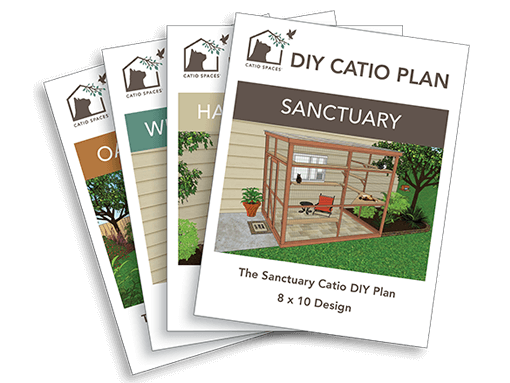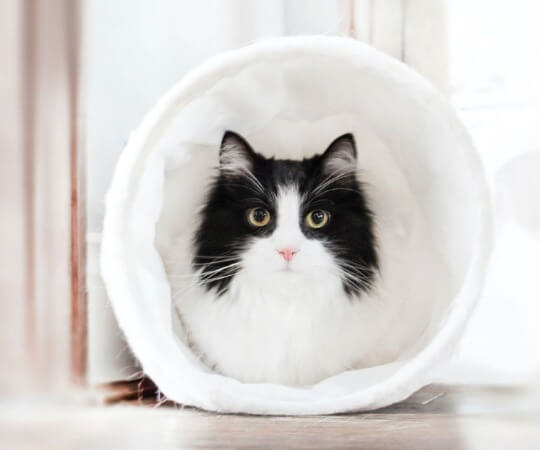
National Take Your Cat to the Vet Day is on August 22! It’s an important holiday and a great reminder that regular vet visits are vital for your cat’s health. Contrary to the common saying, cats don’t really have nine lives. Keeping them happy, healthy and safe is a wonderful way to make sure they live their one life amazingly well.
Anyone who has been around cats long enough knows that they rarely, if ever, complain. Cats often hide the discomfort of common but serious issues like dental, kidney and thyroid disease (among others). Because cats are so good at disguising their pain, taking your cat to the vet for an annual exam is important for your cat’s health and well-being.
It’s best to prevent any health issues before they arise. Preventative medicine, including making sure your cat has regular vet checkups, helps to catch any issues early on so they don’t become life threatening later. For example, nutrition and diet can play an important part in your cat’s health. Your vet will even be able to make any recommendations to help prevent common problems like urinary tract issues, heart disease or overfeeding. Small changes based on your vet’s recommendation can make a big difference.
I recently had the opportunity to talk with Dr. Lora Schuldt, DVM about all things cats and vets. I was delighted to meet Dr. Lora at the Seattle Home Show several years ago where I hosted a Catio Spaces booth to talk to cat-friendly homeowners on the many benefits of having a catio. Dr. Lora and I hit it off immediately and several of my clients take their cats to Cats Exclusive for veterinary services in the Seattle area.
Dr. Lora is a passionate veterinarian who has worked exclusively with cats for 23 years at Cats Exclusive Veterinary Center. Dr. Lora’s mom and both of her grandmothers frequently rescued stray cats, injured birds and baby bunnies. Her fascination with animals—the science and physiology—inspired her career as a vet. Dr. Lora loves dogs too but wanted to develop an expertise with one species.

COMMON REASONS FOR VET VISITS
Cats end up at the vet’s office for many reasons. According to Dr. Lora, some common reasons (besides a regular checkup for preventative care) include limping, vomiting, loss of appetite and urinary symptoms. She frequently treats emergencies such as:
- labored breathing which could indicate heart failure or an asthma attack
- male cats who are straining to urinate which could indicate urethral obstruction
- sudden inability to use one or both hind limbs which could indicate saddle thrombus.
Veterinary professionals take special care to help cats and their human parent(s) be as comfortable as possible during visits, starting from the moment you crate your cat to arriving safely back home following a visit.
Generally, cats have more fear at the vet than other pets, says Dr. Lora. She explains that dogs often get comfort from being around their special human. Cats, however, feel more secure in their home territory. This means a vet visit will be stressful for a cat.
CAT FRIENDLY VET PRACTICES
Cats Exclusive has chosen to be a “Cat Friendly Practice,” following a set of guidelines developed by the American Association of Feline Practitioners and other international cat organizations. The center structures their environment to help minimize any stress and give cats a place similar to home. They give hospitalized kitties boxes to hide in, places to sleep quietly and minimize any beeping noises. And, because they are cats only, a cat will not have to encounter other types of pets, which could be fear inducing.
Dr. Lora and the other staff members use techniques that work with a cat’s instinctive, fear-related behavior, instead of trying to ignore or override it. One trick Dr. Lora uses is examining a cat’s eye with her instrument to the side. Unfamiliar people starring directly in a cat’s eyes can be a scary experience for them.

STRESS-FREE CRATING FOR YOUR CAT
While the struggle of getting a cat into a crate is legend, it doesn’t have to be terrifying. Dr. Lora offers some suggestions to keep your kitty safe and minimize stress when crating to bring your cat to the vet…
- Leave the carrier out and not hidden in a closet. The sound of the carrier getting banged around when pulled out of the closet can create anxiety. Store your carrier in a visible spot in the living space so your cat is used to it.
- Time it right. Rushing in the last 5 minutes to crate your kitty can create unnecessary stress for you and your cat. Chasing your cat and pulling her out from her hiding spot and THEN into the carrier can make your cat not like the crate. Keep in mind though that spending too much time trying to get your cat in the carrier can also increase anxiety. It’s best to strike the right balance.
- Have a plan. You want to quickly secure your kitty in the carrier. Have a swift and sure plan to get your cat safely in the carrier.
- Avoid cornering cats, scruffing them or being loud. All of these can send the pre-vet anxiety high.
When at the vet, Dr. Lora says you can minimize anxiety for your cat by avoiding excessive or loud talking and strong restraint. Also, it’s best practice to only bring the cat being examined into the exam room.
WALLY GOES TO THE VET
One of my catio clients, Wally, recently went to the vet for his annual checkup with Dr. Lora. In advance of his appointment and per COVID-19 protocols, cat parents are asked to provide an update on their cat’s state of wellness. I couldn’t help but share Wally’s letter from his cat mom Sharon Kabelac:
Dear Dr. Schuldt,
Wally is scheduled to visit you Thursday morning this week. I hope to win the carrier wrestling contest. Wally presents with young, strong, healthy, Rookie of the Year behaviors. Wally is also high strung to the max. Any sound from the street, opening a door, ringing phone, or God help us a stranger in the house, sends him immediately to his blanket. He has a secure enclosed location under the blanket where he can see no one and therefore no one can see him.
Sharon’s technique for getting Wally into the carrier and driving to the vet is a well-thought out process:
“The carrier always stays under a tall table in the cats’ ‘playroom’ aka sun room. It’s open all the time with a toy or two tossed in for interest. Therefore, Wally is not surprised to see the carrier,” Sharon says. “When it comes the time to take a ride, I quietly pick up the carrier and carry it to the room he happens to be in. I don’t look or talk to him, and I leave the room. I wait until he’s ‘forgotten’ the carrier – 1/2 hr. or so, napping usually. Then I can walk up to him, slip my hands under his sleepy body speaking softly about how he’s a good boy, turn to the nearby open carrier and slip him firmly in through the door. I’m a longtime practiced flap/door closer: one hand swiftly holds shut the entry and the other zips/clicks the security latches.”
Sharon has mastered the right strategy to get Wally in the carrier.
Car rides to the vet can be stressful though and is an issue for 99% of cat companions. To avoid howling, screaming, pleading, vomiting, peeing or pooping (more than one disaster, if you’re unlucky), Sharon keeps the windows closed, music low and mellow and sets out very slowly. In fact, she drives slowly all the way! Her cats tolerate a speed up to 15 mph. If it’s necessary to jump up to 20 mph, Wally will remind her by pitching his voice higher and louder.
Different cats will have different tolerances with car rides. For very-stressed cats, Dr. Lora doesn’t believe cat parents should try to “de-sensitize” cats by putting them in cars more frequently.
“This is asking them to repeatedly tolerate something quite terrifying and un-natural, which will likely make them more fearful in general,” says Dr. Lora. “None of my personal cats have ever howled, panted or vomited during a car ride and I think this is because I try to work quickly and quietly to get the job done. I don’t play the radio, talk or run the AC in the car. I also don’t recommend talking to cats who are yowling. It can reinforce the behavior when you say ‘It’s OK, Puddin.’”

REDUCING TRAVEL ANXIETY FOR YOUR CAT
For very stressed cats, talk to your vet about how to make car travel more pleasant. Dr. Lora says it’s normal for a cat to show signs of fear while riding in a car. Cat parents can avoid carsickness by fasting your cat at least 4 hours prior to the trip. Sometimes a prescription medication like Cerenia can help with carsickness too.
“Synthetic feline facial pheromones can be helpful, but usually need to be part of a greater stress reduction plan, regardless of what behavior you’re trying to correct,” says Dr. Lora. “For example, a cat with inappropriate urination associated with anxiety will definitely need more than a pheromone.” If your cat’s car travel anxiety is mild to moderate, pheromones might be a good solution. Dr. Lora recommends spraying or wiping the carrier with pheromones 30 minutes or more before putting your cat inside. Prepackaged pheromone wipes are easy and fast to use, and you can store them inside the carrier so they are handy for the next time you travel with your cat. Composure treats could also be a solution for mild anxiety.
Cats who experience moderate to severe travel anxiety may be prescribed Gabapentin. “Many cats will eat the medication in food prior to the appointment,” explains Dr. Lora. “It can allow us veterinarians to complete a more thorough exam and avoid more potent sedatives for the patient.”
According to Dr. Lora, Gabapentin is safe to use alongside other anesthetics or sedatives. “Many of our dental patients are pre-medicated with Gabapentin prior to receiving general anesthesia, and it both relieves pre-surgical pain and anxiety as well as prevents post-operative discomfort after extractions.”
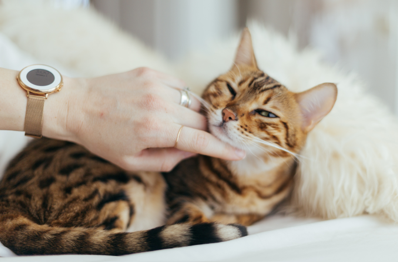
RETURNING HOME FROM THE VET
Make the return home from the veterinarian a calm and welcoming experience. Food-motivated cats may enjoy an extra meal or some treats when they get home from the vet, according to Dr. Lora. It serves as a nice distraction and may induce a little catnap. It’s best to let your cat simply be. If she wants to hide, then let her.
Other household cats sometimes hiss in alarm when their cat sibling returns from the vet. They may even try to follow them around or sniff them incessantly.
Dr. Lora says vets think this happens for a couple reasons. Unlike humans, cats don’t instantly recognize another cat that they ‘know.’ They rely on other factors such as scent. A cat who just came back from the vet may smell different. The patient may also be releasing negative pheromones and/or showing other signs of fear in her behavior. All of this can alarm a cat that was at home.
To avoid hissing or any issues between the patient and other cats at home, Dr. Lora recommends to “keep them separate until the patient appears quite calm, and let the patient dictate the level of interaction, not the cat who stayed home. Feeding them both treats several feet apart from each other (social distancing while eating is critical for stress relief, and not just during a pandemic!) can help distract them and work as a ‘reset’ button in many cases.”
KEEPING YOUR CAT SAFE AT HOME
Cat-life for free roaming, outdoor cats adds hazards that can increase accidents and veterinary visits. Keeping cats safe is important to Catio Spaces and veterinarians, which is why a catio, a cat enclosure, is a wonderful option for parents looking to give their kitty a safe, enriching, outdoor environment.
Dr. Lora believes outdoor cats should be microchipped. Some of her other recommendations for cats that go outdoors include:
- Bring your cat indoors at evening time
- Don’t allow unmonitored access to food when your cat is outside
- Stay up to date with vaccines (leukemia vaccine is important for younger cats)
- Flea control is a must from August-November in the Seattle area. Dr. Lora reports that cats that go outdoors experience more flea-related problems and contagious illnesses.
“Fighting with other cats outside is a real problem because cats are so territorial,” says Dr. Lora. “Creating a calm, feline friendly home where your cat can establish a secure territory will go a long way toward keeping them safer and happier. And happy cats are what we’re all about!”
Leash walking is one way to give a curious cat safe access to the outdoors. It does take time to train them properly. To be successful leash-walkers, it’s best to train your cat in step-by-step increments, according to Dr. Lora. Check out The Anti-Cruelty Society step-by-step guide to leash-walking if you’re interested in taking your cat for a walk!
A catio enhances your home and provides a calm, safe and enriching space for cats. Catios are one way to give your cat access to the great outdoors while still keeping them safe from predators or environmental dangers such as cars, poisons or diseases from other animals.
Tuxedo cat Wally gets preened by cat mate Mila in their backyard catio.
Wally is a big fan of his catio that he shares with cat mates Sally and Mila. The custom built catio by Catio Spaces has a wire mesh roof and features grass, cedar shelves, carpeted perches and a deck for lounging. His human mom, Sharon, enjoys watching her fur kids from the kitchen window.
“Wally loves to lie in the grass in the catio in springtime. It’s the best. I leave it uncut until warmer weather dries it up and it’s not luscious anymore. He lies flat on the ground and you can see only the two dark pinnacles of his ears perched on the field of green,” says Sharon. “Wally knows the rabbits will come through into the yard to eat the clover. He’s watching and waiting for the dance of the sugar plump bunnies.”
“I think catios are a fabulous way to allow outdoor activity safely,” says Dr. Lora Schuldt, DVM
Catios are a great way to satisfy your indoor cat’s curiosity… and to protect your indoor/outdoor cat from harm.

Take Your Cat to the Vet Day is here and it’s time to schedule a visit to the vet for an annual checkup! Vets can help us give cats a wonderful, happy and fulfilling life. And one of the best options to reduce the stress of a vet visit for your cat is spending time in a catio!
The many benefits of catios make them the purrfect solution to keep your cat safe and provide peace of mind. You can create a custom catio like Wally’s own special sanctuary, or choose a DIY Catio Plan for a window, deck, patio or yard.
If you want to prevent unfortunate accidents and emergency medical visits by giving your cat a safe, secure outdoors environment… it’s time for a catio!
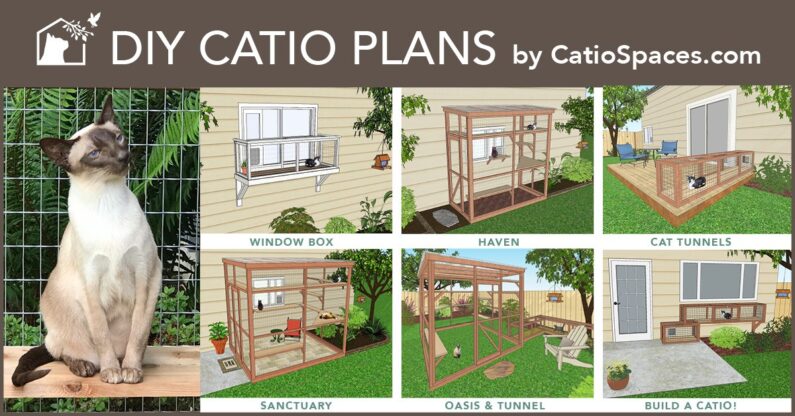


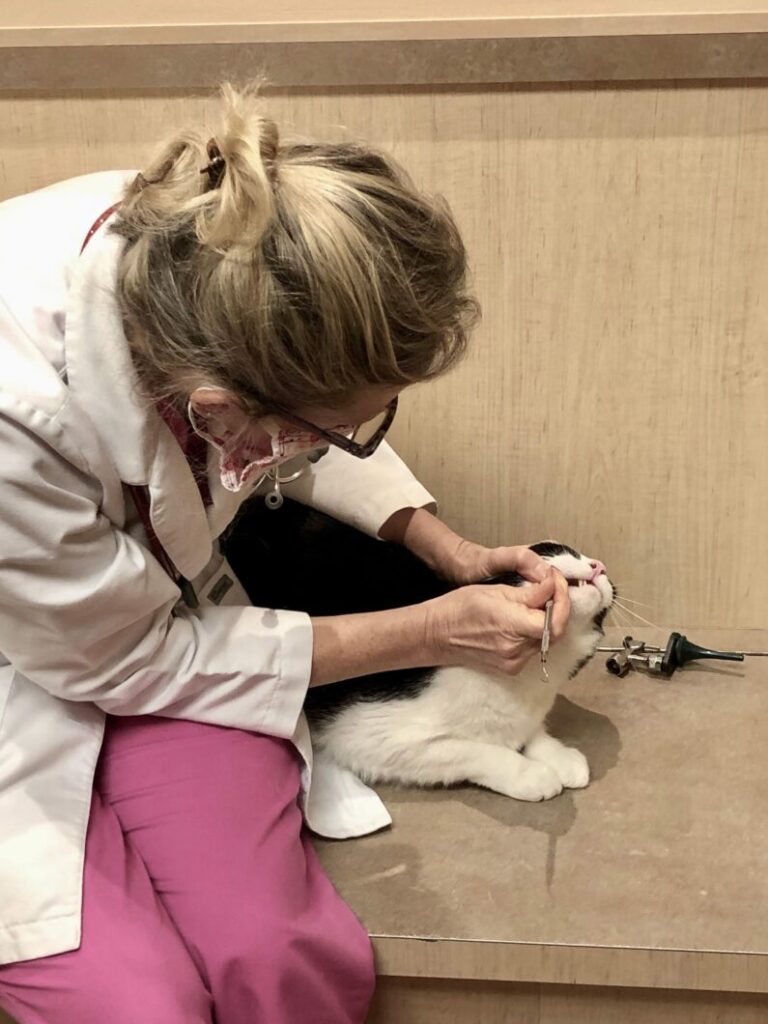
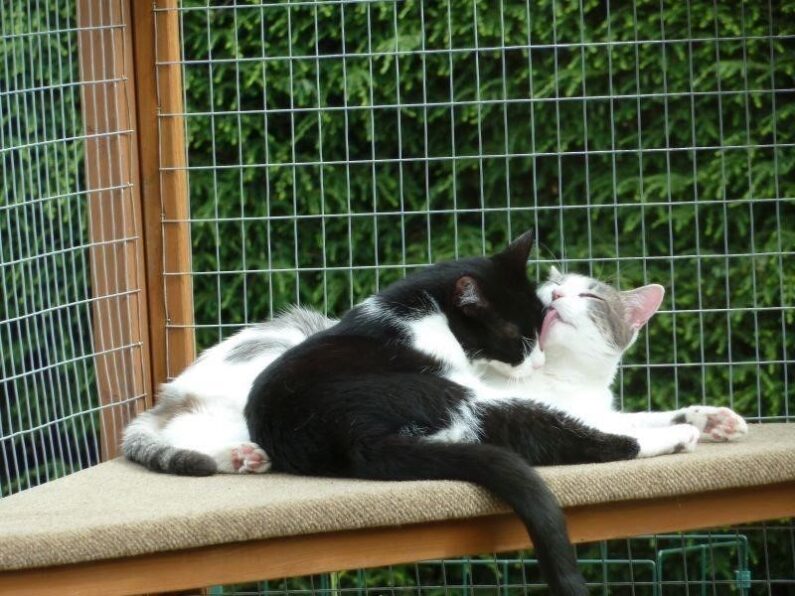
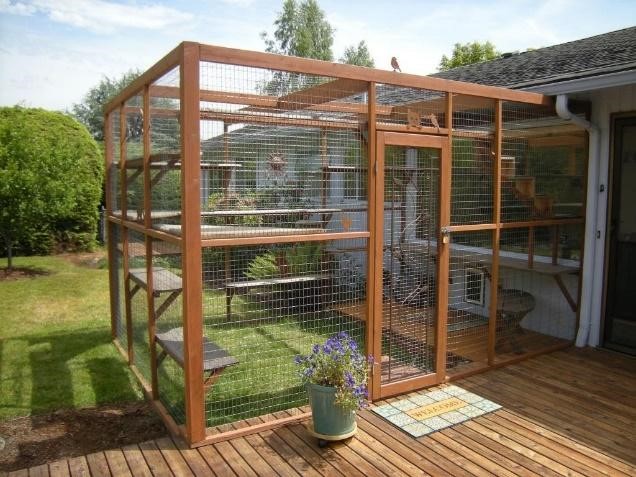
 Cynthia Chomos is a
Cynthia Chomos is a 
